Woo hoo – let’s hope it’s permanent!
From Care2:
Success! Super Trawler Banned From Australia’s Oceans
E. Fudd
Woo hoo – let’s hope it’s permanent!
From Care2:
Success! Super Trawler Banned From Australia’s Oceans
E. Fudd
From Care2:
100 Rhinos Slaughtered In Less Than Two Months
100 rhinos have been killed in less than two months in South Africa’s Kruger National Park. AFP reports that this “surge” in rhino killings by poachers means that the number of the endangered animals killed this year could surpass the total of 381 killed last year.
80 percent of the world’s remaining 20,000 rhinos live in South Africa. Driving the killings is the black market for rhino horns in Asia — including Malaysia, South Korea, India and China — where the horns are thought to have healing properties.
Rhino horns are composed completely of keratin, which is found in hair, fingernails and animal hooves; chemical examination of the horns has shown that they are similar in structure to the beaks of turtles, cockatoo bills and horses’ hooves. In traditional Chinese medicine, the horns are ground up into a powder that is dissolved in water to treat fever, rheumatism, gout and other conditions. A PBS reports cites a 16th century Chinese pharmacist, Li Shi Chen, who said that rhino horns could be used for all manner of ailments including snakebites, hallucinations, typhoid, headaches, carbuncles, vomiting, food poisoning and even “devil possession.”
PBS cites a 1990 Chinese University in Hong Kong study that found that “large doses of rhino horn extract could slightly lower fever in rats (as could extracts from Saiga antelope and water buffalo horn).” But the concentration of horn used by practitioners of traditional Chinese medicine is much less than scientists used in their experiments.
In 2007, thirteen rhinos were killed. In 2010, that number rose to 333.
South Africa has deployed soldiers and investigators to the parks to fight the poachers. But the real issue is the external demand for the horns. As Albi Modise, a spokesman for South Africa’s department of environmental affairs says to AFP, “You can put all the resources at home, but if you don’t address the demand outside South Africa, you will not win the battle.”
Rhinos are being killed in increasingly larger numbers so their horns can be used for outmoded and inaccurate medical theories that will, it seems too likely, exist long after the last rhino dies.
E. Fudd
Even their superstitions say it’s a bad idea! E. Fudd
The superstition:
Some years ago there lived a wealthy fisherman called Matsushima Tomigoro at Matsushima, in Nagasaki. He made a large fortune by whale-fishing. One night he dreamed a strange dream. A whale (zato kujira), carrying a baby whale, appeared before his pillow, and requested him to let her and the baby go safely–they were going to pass a certain part of the sea at a certain time and date. Matsushima heartlessly did not accede, but took advantage of the information. He put a net in the said sea at the due time, and caught a whale and her baby. Not long after, the cruel fisherman began to reap the harvest of his mercilessness. Misfortune after misfortune befell him, and all his wealth disappeared.
‘It must be the result of his cruelty in killing the whale and its baby,’ said the neighbours; and for some time they never caught whales carrying babies.
The event that occurred in 1878:
As the year of 1878 dragged into winter the beach-master or ‘ami-moto’ was getting desperate. At that time there were two hereditary leaders in Taiji. One was Taiji Kakuemon, who ran the business operations, and the other was his relative, Wada Kinemon, the advisory head. On December 24, 1878, after a bleak, poverty-ridden period of poor catches, a big female right whale and her calf were spotted by the lookouts. The triple black and white pennant was raised and the whalers momentarily relaxed, for the whalers knew that a female and her calf were not to be hunted. It was late afternoon, and for a successful hunt, a whale would have to be killed and secured before nightfall.
At the beach in front of the shrine of Asuka, the two leaders argued. Kakuemon insisted that the village needed a whale, and needed one before the New Year. Kinemon said no, it was not their custom to hunt a female with calf, and that it drew late, that bad things would befall them if they broke this rule.
Nevertheless, Kakuemon gave the order to hunt, and as the red signals went up and the conches blew from the lookouts, the surprised whalers jumped to their long sculling oars and the gaudy, sleek boats darted forward. The whale was enmeshed and harpooned, but she fought with great fury, and dragged the boats out to sea. Cold winds were blowing from the shore and the men became cold and exhausted. It got dark. By morning the fleet was scattered, and no matter how hard the men in the boats attempting to tow the whale struggled at their oars, the winds, current, cold and the sheer size of the whale was too much for them. Finally, in tears, they cut the whale loose. The storm grew worse.
Within a few days, the cream of the Taiji whalers, and the best of their boats, had been swept far out to sea and had died from exposure or drowning. Some drifted as far as the seven islands of Izu. Estimates of the death roll vary from 111 to 130 men killed. Only a handful survived.
Taiji Kakuemon, in his grief, gave his entire family estate to the bereaved families, and eventually left Taiji for good. The village was plunged into an awful depression, and many young men left for foreign shores, for Hawaii, California, Canada, Mexico. Many of the dances, skills and sea lore of the whalers died with those men who chased the taboo female, and although there were attempts over the next two decades to rebuild the net whaling fleet, they had small success.
C.W. Nicol
February 1979
Taiji, Japan

E. Fudd
And Slade Gorton’s perennial lies and legal obstacles to stop it – now proven the BS that they were! Suck it, Skeletor – you were WRONG.
Elwha: The largest dam removal in history hits one-year mark
E. Fudd
Starting with YOU, Liam Neeson!
From the L.A. Times:
Protect wolves at Denali National Park, wildlife activists plead
From Care2:
A Buffer Zone Could Go A Long Way For Wolves in Denali
E. Fudd
you restore an ecosystem major predator, and balance ensues…. E. Fudd
Cool Kickstarter project…. E. Fudd
Milkweed for Monarchs Butterfly Garden
WHAT’S THIS PROJECT ALL ABOUT?
Our goal is to help restore monarch butterflies in North America, starting with our own yard. With your help, our project will create a Monarch Waystation that is certified by MonarchWatch.org.
Monarch butterfly numbers are plummeting because of a lack of milkweed and severe storms in their overwintering grounds in Mexico. Monarch Waystations (monarch habitats) are gardens that include the right plants to support the entire monarch life cycle. This requires milkweed for caterpillars, nectar plants for adults, protection from wind, weather, and predators, and maintenance without the use of pesticides.
We ask you to join us and are grateful for whatever level of support you feel comfortable with. In return, you will receive your choice of Custom Milkweed and/or Nectar Seed Packets, Awesome Screen Savers, Museum-quality Photographs, and/or personal time with two passionate conservationists.
KICKSTARTER
Kickstarter is all or nothing. We HAVE to raise our goal or no money gets transferred. Your donation will be charged to your credit card after our Kickstarter Project ends if, and only if, we meet our goal.
We will be forever grateful to each and everyone one of you who contributes. THANK YOU!
THE PLAN
Your support will fund the materials and services listed below.
* Landscaping expert to confirm design layout for raised flower beds and best host, nectar, and windscreen plant selection, number, and placement
* Raised flower beds to build this fall adjacent to our BioHedge. This will optimize access to existing early and late season nectar sources (trees and shrubs) and reduce deer fence and irrigation expenses (We provide the labor) Also, since many types of milkweed require extended periods of cold (winter) before they will germinate, we will have time to plant them by November.
* Clean fertile soil (Need soil delivered)
* Drip irrigation system (Leo will install)
* Deer fence to extend around BioHedge and new raised beds (We provide the labor)
* Milkweed and nectar plants and seeds plus flowering shrubs for windscreens and additional nectar
* Grow lights and tabletop greenhouses to start seeds inside
* Compost Bin to create rich, natural fertilizer
* Caterpillar sleeves and mesh greenhouse to “Raise and Release” eggs and caterpillars found on nearby milkweed
THE BIG PICTURE
After our Monarch Waystation is established, our plan is to begin breeding monarchs and releasing them back into the wild. Why? In the wild, a monarch egg has about a 3-5% survival rate. Butterfly breeders report a 95% survival rate.
Later, after we have mastered the art of monarch breeding, we will launch a statewide campaign to restore butterflies by involving Montana teachers. We will offer free monarch eggs and caterpillars to teachers who create a classroom project that results in a Monarch Waystation*. Grant money for school gardens is available as well as many free online resources for classroom projects. We’ll share our sources to find them.
Finally – We live 30 miles from Yellowstone National Park, which draws 3 million visitors a year. Our ultimate goal is to create an interpretive traveling exhibit, including live butterflies, and promote Monarch Waystations during summer presentations held in or near the park.
That’s our vision, and it all starts with YOUR help!
If you’d like to join us and restore monarchs in YOUR area, as well, we’ve put together some great rewards for you!
From Care2:
World Ocean Health – A Failing Grade
and from the source article in Nature (entire article avail. for purchase at link with higher-res images included of course):
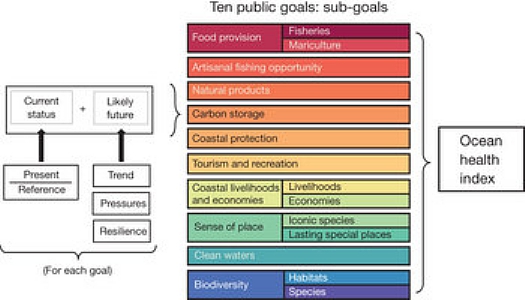
Each dimension (status, trend, pressures and resilience) is derived from a wide range of data. Dimensions combine to indicate the current status and likely future condition for each of ten goals….
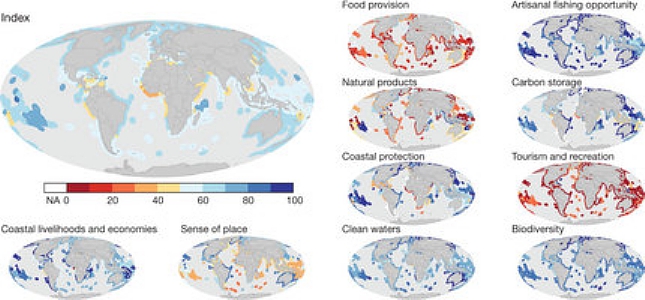
All waters within 171 exclusive economic zones (EEZs), that is, up to 200 nautical miles, were assessed and are represented on the map.
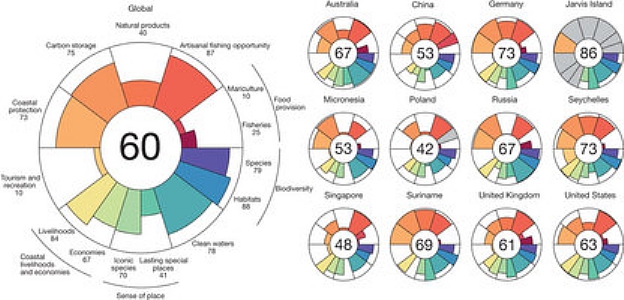
Index scores (inside circle) and individual goal scores (coloured petals) for global area-weighted average of all countries and for several representative countries.
The outer ring is the maximum possible score for each goal, and a goal’s score and weight (relative contribution) are represented by the petal’s length and width, respectively…..
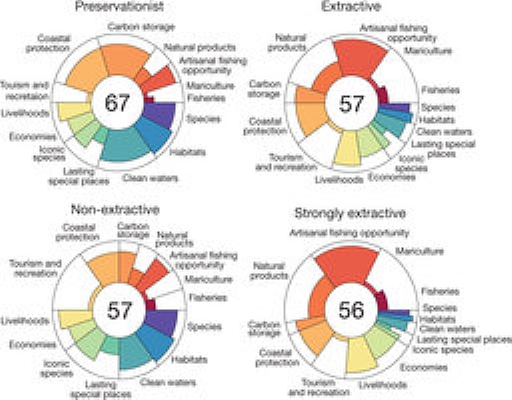
Value sets are illustrative rather than prescriptive; labels for the value sets are approximations and should not be interpreted literally.
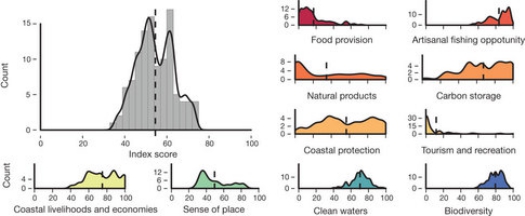
Histogram plots are smoothed across five point bins; dashed vertical line is the arithmetic mean and so differs from the area-weighted mean in other figures. Note different scales on y axes.
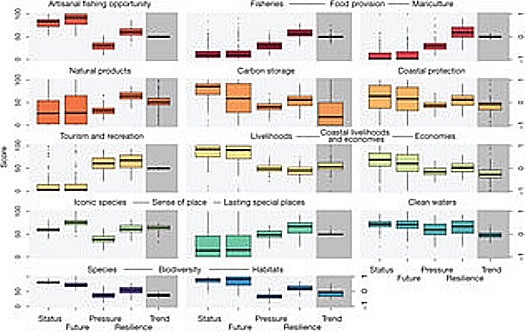
Histograms are shown separately for each sub-goal. Note the different scale for trend (right y axis).
E. Fudd
Why is there a debate about this? – YES YES YES!!!!
North Cascades National Park: Make it bigger?
E. Fudd